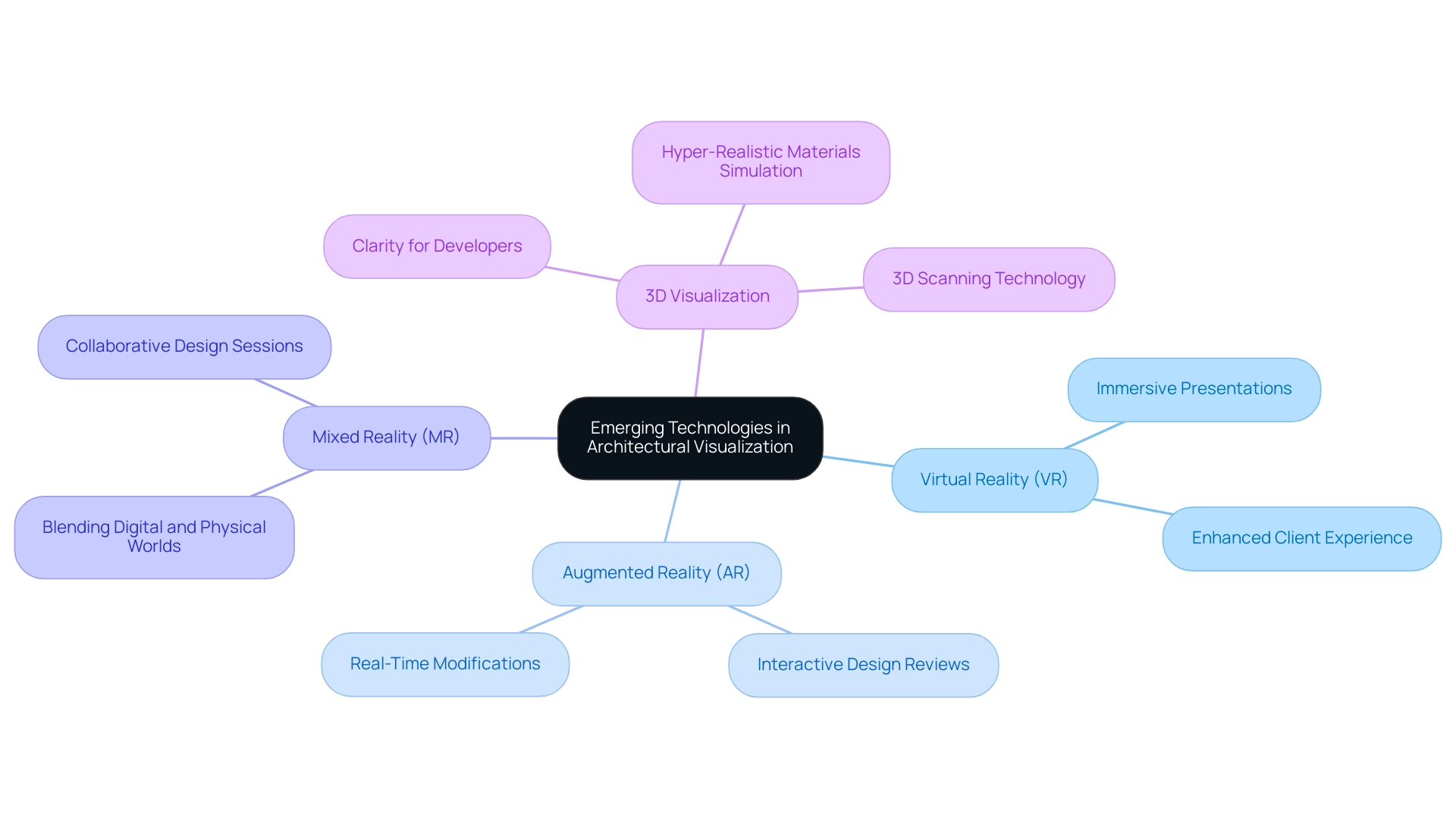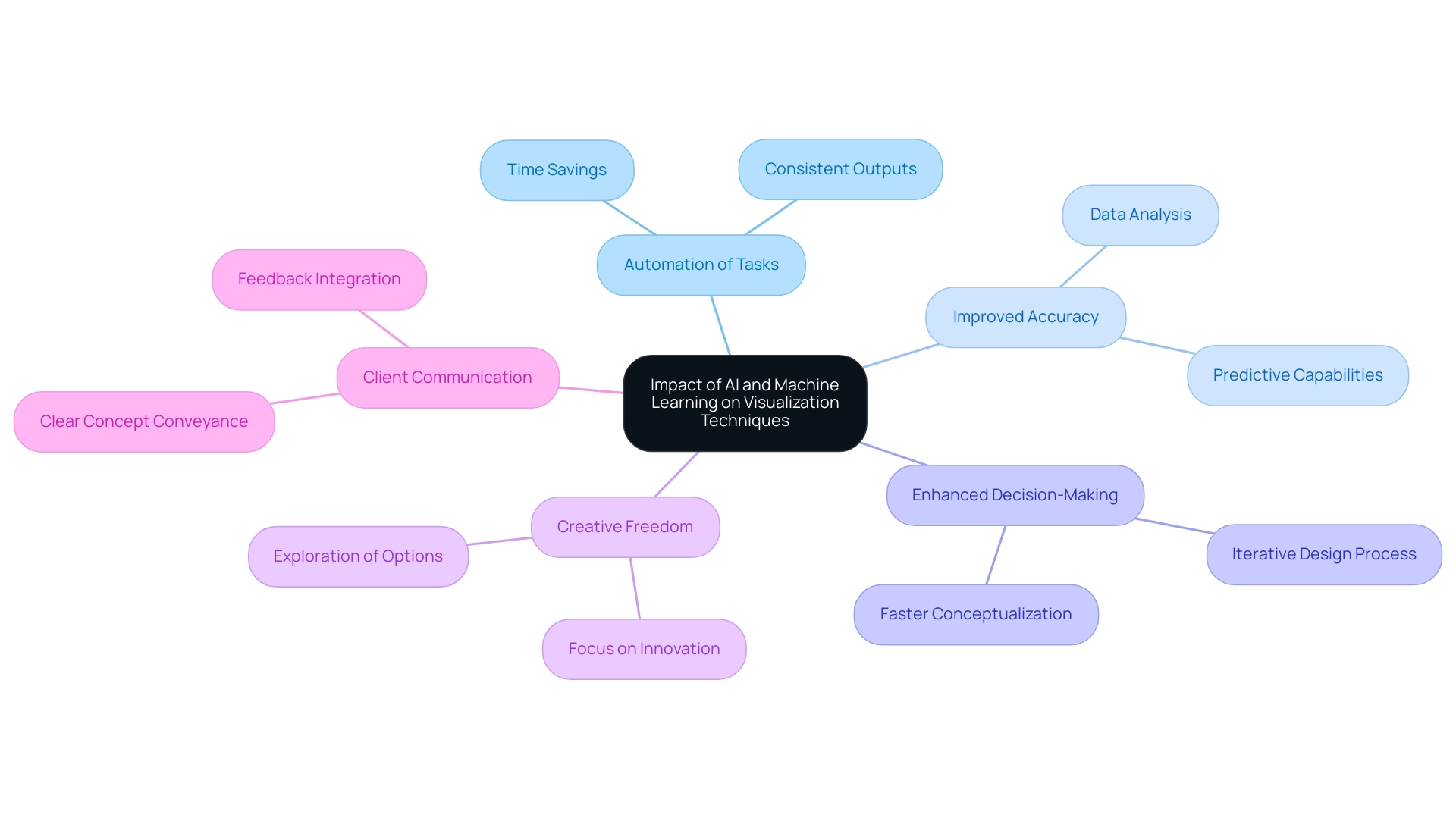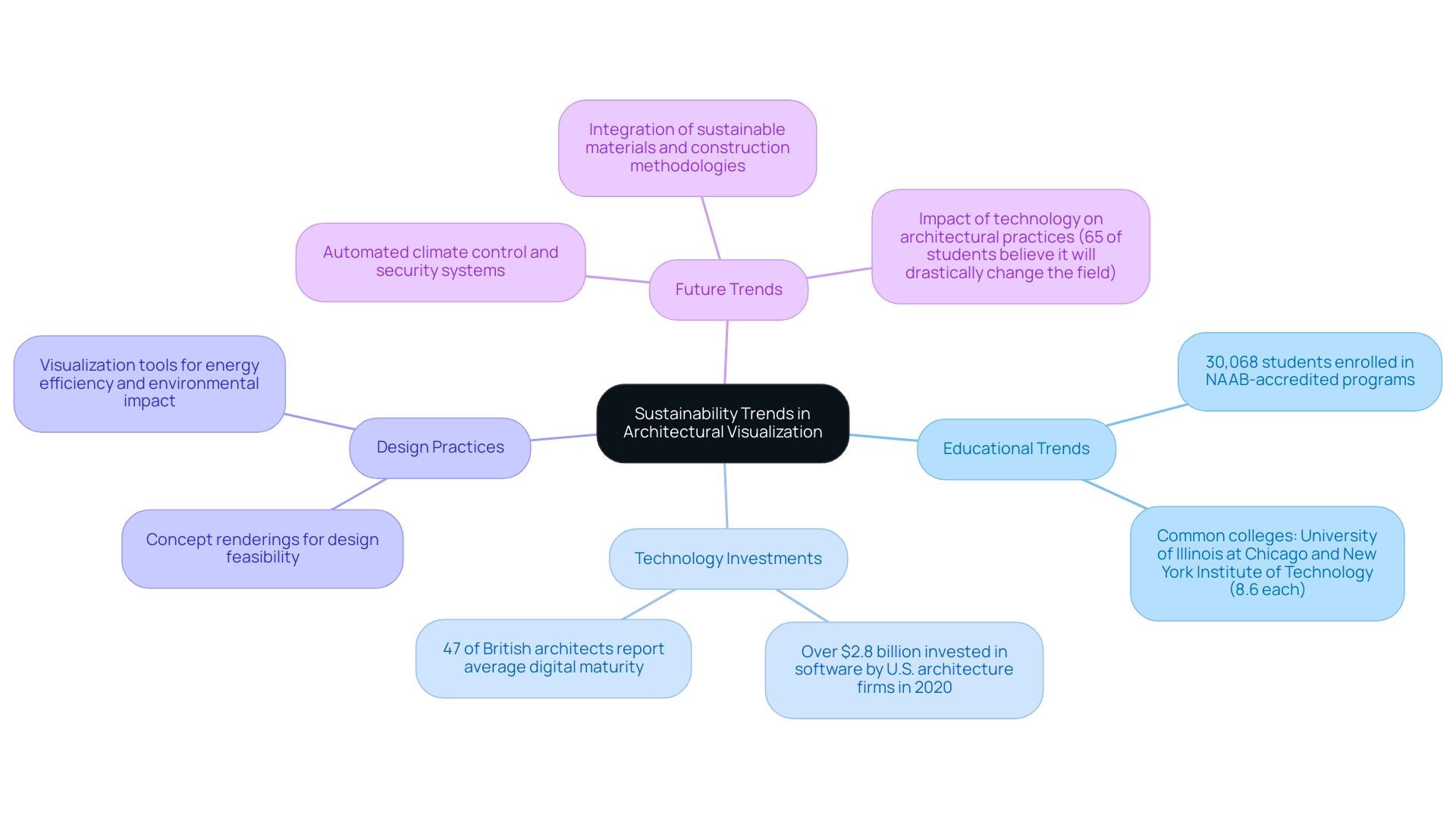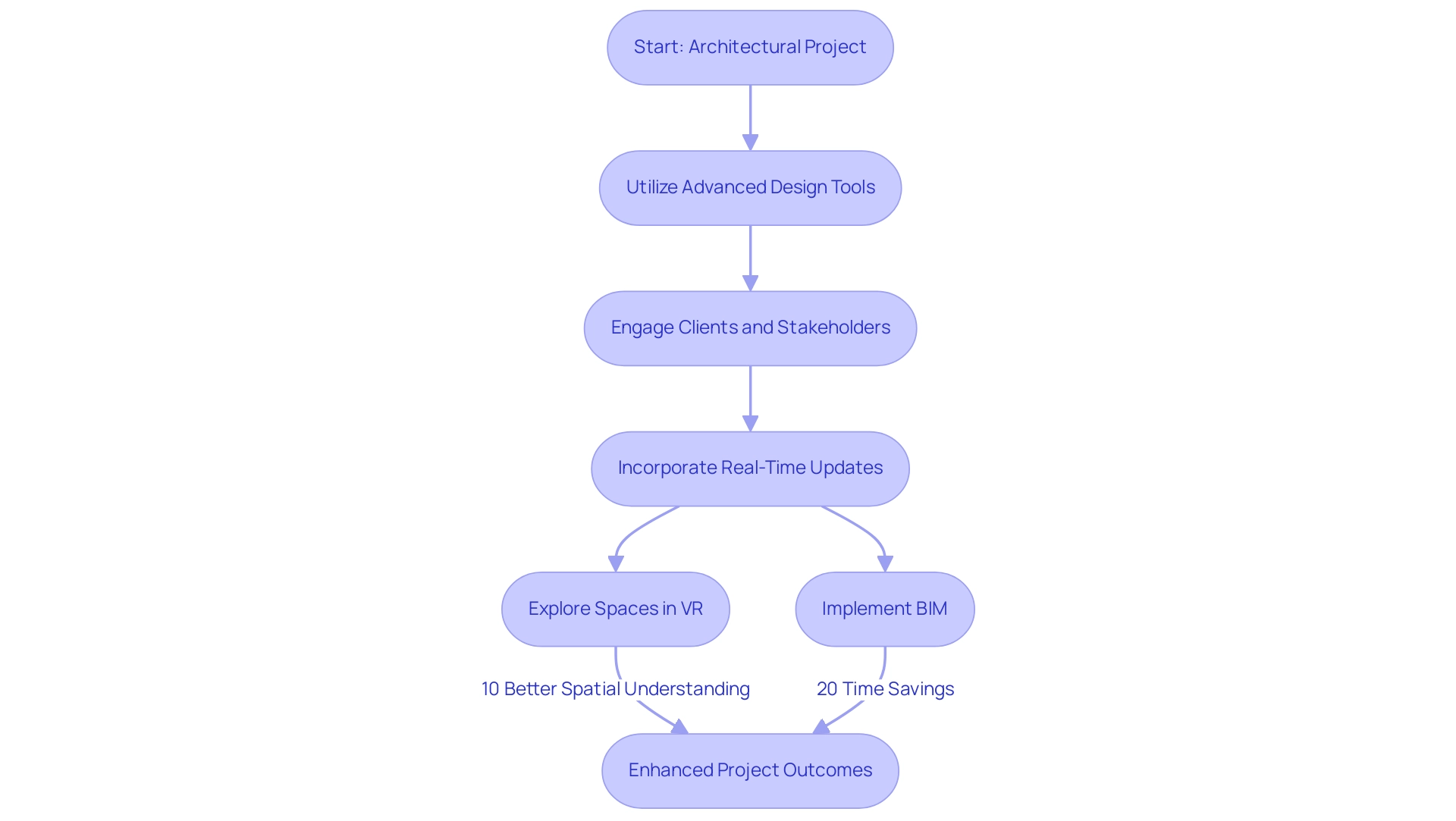Overview
The top trends in the future of architectural visualization technology include the integration of virtual reality (VR), augmented reality (AR), and advancements in AI and machine learning, which enhance client engagement and streamline design workflows. The article illustrates how these technologies facilitate immersive experiences, improve communication among stakeholders, and support sustainable practices, thereby transforming architectural processes and outcomes.
Introduction
The architectural visualization landscape is experiencing a profound evolution, driven by the adoption of cutting-edge technologies such as virtual reality (VR), augmented reality (AR), and artificial intelligence (AI). As approximately 70% of architecture firms integrate VR into their practices, the shift towards immersive design is becoming increasingly evident. These advancements not only enhance the quality and realism of visual presentations but also facilitate improved collaboration among stakeholders, ensuring alignment with project visions.
Furthermore, the rise of sustainability trends and the integration of real-time rendering technologies are reshaping the way architects approach design, allowing for more informed decision-making and client engagement.
This article delves into the transformative impact of these emerging technologies on architectural visualization, exploring their implications for design workflows, client satisfaction, and the future of the profession.
Emerging Technologies Transforming Architectural Visualization
The landscape of architectural visualization is undergoing a significant transformation, largely driven by the trends in the future of architectural visualization technology, including the integration of emerging technologies such as virtual reality (VR), augmented reality (AR), and mixed reality (MR). Significantly, roughly 70% of architecture firms have started employing virtual reality in some capacity, reflecting a rapid transition towards more immersive creative practices. These technologies empower architects to create interactive and engaging presentations, allowing clients to experience designs in a fully immersive environment.
Additionally, 3D townhome visualization has become an empowering tool for developers, providing clarity and certainty in a field where these qualities are highly coveted. By equipping developers with powerful narratives that can facilitate communication with builders, lenders, and municipalities, these renderings bridge the gap between concept and reality. They enable stakeholders to visualize the project in detail, fostering collaboration and ensuring that everyone involved is aligned with the vision.
Furthermore, advancements in hyper-realistic materials simulation enable architects to visualize materials under varying lighting conditions, enhancing the overall realism of their presentations. Advancements in 3D scanning technology also enable more precise representations of existing environments, seamlessly incorporating them into new creations. A key advancement in this field is Chaos’s integration of AI-driven asset enhancement into their Enscape software, which significantly enhances the realism of representations without compromising performance.
Collectively, these tools not only enhance the quality of graphics but also streamline design workflows, contributing to more successful project outcomes and improving client satisfaction. Moreover, the architecture industry is witnessing trends in the future of architectural visualization technology, as investments in software and technology reached over $2.8 billion in 2020. This shift underscores the increasing importance of technological adoption in architectural practices, including the role of pre-sales visualization in generating investment and project confidence.
As noted by Zippia, Virginia stands out as the best state for architects to live in, further highlighting the evolving landscape of the profession. To experience the transformative power of 3D townhome rendering and enhance your project communications, reach out today and let us help bring your architectural visions to vibrant life.
The Impact of AI and Machine Learning on Visualization Techniques
Artificial intelligence and machine learning are fundamentally transforming architectural visualization by automating intricate tasks and improving accuracy, showcasing trends in the future of architectural visualization technology. AI-driven software is skilled at analyzing extensive datasets, facilitating the prediction of results with remarkable precision. This capability enables planners to accelerate decision-making processes, ultimately resulting in more informed and timely choices.
Furthermore, machine learning algorithms are revolutionizing visualization techniques, which are key trends in the future of architectural visualization technology, facilitating the rapid production of high-quality visual outputs. By simplifying repetitive tasks, these technologies liberate professionals to focus on the creative aspects of their work, promoting a culture of innovation and resulting in more effective solutions.
In addition to these technological advancements, the use of initial conceptual images provides significant advantages in the architectural planning process. These illustrations offer fast visualization of concepts, enabling builders to investigate various creative options swiftly. They are cost-effective, focusing on basic shapes and massing, which makes them ideal for early-stage exploration.
By facilitating early-stage decision-making, these visuals assist stakeholders in evaluating different creative directions, which aligns with the trends in the future of architectural visualization technology, without committing extensive resources. Notably, the iterative design process supported by preliminary visuals ensures that architects can refine their ideas based on feedback and new insights, which reflects the trends in the future of architectural visualization technology and further enhances the design quality.
Moreover, effective communication is improved, as these visual models allow architects to convey their concepts clearly to clients and other stakeholders, ensuring everyone is aligned from the outset. For instance, one of our clients stated, ‘The initial visuals allowed us to conceptualize our ideas quickly and make adjustments before proceeding, saving us both time and money.’ Client testimonials play a crucial role in reinforcing the value of these practices.
At J. Scott Smith Visual Designs, we pride ourselves on building lasting partnerships and delivering exceptional results. Our clients have shared their experiences, emphasizing the importance of trust, reliability, and a shared vision in architectural representation. Their honest feedback not only reflects our dedication to exceeding expectations but also highlights the necessity of skilled professionals in navigating the complexities of emerging technologies.
As our clients demonstrate, the combination of advanced visualization methods and a dedication to client satisfaction ultimately propels successful creative results.
Real-Time Rendering and Immersive Technologies: The New Standard
Real-time rendering has emerged as a pivotal advancement in architectural visualization, enabling designers to generate high-quality visualizations instantaneously. This capability allows for immediate updates to plans, a feature that proves invaluable during client consultations. The importance of providing clear and timely information cannot be overstated; as noted in our experience, giving the right specifications early saves both time and money.
When integrated with immersive technologies such as virtual reality (VR) and augmented reality (AR), architects can craft interactive experiences that permit clients to navigate proposed spaces prior to their construction. This not only significantly enhances client satisfaction by providing a tangible sense of the design but also facilitates the early identification of potential design flaws, thereby minimizing costly revisions later in the project lifecycle. Our case studies illustrate how pre-sales representations foster confidence in projects, serving as vital assets that ignite interest and investment long before physical construction begins.
For instance, one case study illustrated how a detailed pre-sales depiction attracted multiple investors, leading to a 30% increase in funding compared to similar projects without such visualizations. Furthermore, the collaborative planning process is essential; we encourage client feedback at every stage, ensuring alignment with their vision and enhancing the overall project outcome. As the demand for sustainable architecture is expected to increase by 16.4% each year until 2027, architects will find that trends in the future of architectural visualization technology will be essential to satisfy changing market expectations.
Additionally, NVIDIA’s introduction of the Earth Climate Digital Twin for weather forecasting underscores how technological advancements can mitigate economic losses from extreme weather, highlighting the importance of innovation in architecture. CADVIZ, an architectural design firm, emphasizes the accessibility of these technologies, stating, ‘With CADviz, customers do not require any specific skills to render an image by just dragging and dropping a screenshot of their model.’ Moreover, the Asia Pacific region is anticipated to experience significant growth in the 3D rendering market, driven by industrial growth and increased demand in sectors like architecture and gaming, creating a favorable environment for the adoption of real-time rendering technologies.
Sustainability Trends in Architectural Visualization
Sustainability has emerged as a pivotal theme in architectural visualization, prompting many firms to integrate eco-friendly practices into their workflows. In the academic year 2022-2023, a notable 30,068 students enrolled in NAAB-accredited programs, signaling a growing commitment to sustainable architecture among emerging professionals. Notably, the University of Illinois at Chicago and New York Institute of Technology are among the most common colleges for personnel in design, each accounting for 8.6% of graduates, emphasizing the educational foundations supporting this shift towards sustainability.
Furthermore, 47% of British designers believe their digital maturity is average, indicating a readiness to adopt new digital tools, while U.S. architecture firms invested over $2.8 billion on software and technology in 2020. Visualization tools, including concept illustrations, are increasingly utilized to simulate energy efficiency and evaluate environmental effects, enabling architects to make informed choices. These high-quality visual representations act as a ‘window into the future’ of projects, enabling stakeholders to envision potential concepts and comprehend the underlying vision behind blueprints.
Concept renderings, in particular, are cost-effective tools that help explore design feasibility by focusing on basic massing and form without the distraction of textures and colors. For instance, advanced software capable of analyzing sunlight exposure and energy consumption enables designers to create buildings that significantly reduce their carbon footprint. Additionally, the incorporation of tools that visualize sustainable materials and construction methodologies fosters greater client understanding and commitment to green building practices.
As noted by prominent designer Pickard Chilton, ‘As the industry evolves, these trends will play a crucial role in shaping a sustainable future for architecture.’ A case study exemplifying this shift is the utilization of automated climate control and security systems, which not only enhances user experience but also promotes efficiency, sustainability, and resilience within modern buildings. Ultimately, the integration of these representation techniques reflects the trends in the future of architectural visualization technology, as well as the broader sustainability trends currently reshaping architectural representation, while also addressing the complexities of project scale that influence rendering time and resource requirements.
Enhancing Collaboration Through Advanced Visualization Tools
Advanced design tools are transforming collaboration among architects, clients, and stakeholders, reflecting the trends in the future of architectural visualization technology in contemporary architectural projects. By utilizing platforms that provide real-time updates and shared access to visualizations, all parties can engage more effectively in the creation process. This collaborative framework not only fosters creativity but also guarantees that client feedback is seamlessly incorporated into the evolving plan, aligning with the client’s vision and enhancing project outcomes.
Notably, participants who explored spaces in VR demonstrated a 10% better spatial understanding compared to those relying solely on 2D floor plans, highlighting the effectiveness of these advanced tools. Furthermore, firms employing Building Information Modeling (BIM) report an average time saving of 20% on projects, leading to reduced labor costs and enhanced cost efficiency in architecture and design. Providing the right information early in the process is vital, as it can save time and money, allowing for a smoother workflow.
A significant case study emphasizes how meticulous details in illustrations can showcase functionality and aesthetics, significantly improving client satisfaction and marketing effectiveness. Additionally, pre-sales representation serves as a bridge between concept and reality, generating interest and investment crucial for project success. Trends in the future of architectural visualization technology are exemplified by cloud-based rendering services, such as those provided by leading firms, allowing architects to produce interactive 3D models that facilitate discussions and informed decision-making.
The result is a more cohesive approach to project development, significantly enhancing overall outcomes. As emphasized by WMB-ROI, ‘A well-crafted architectural visualization leaves nothing to the imagination,’ underscoring the critical role of advanced tools in the architectural design landscape and the encouragement of client collaboration at every stage of the process.
Conclusion
The architectural visualization sector is undergoing a transformative shift, primarily propelled by the integration of advanced technologies such as virtual reality (VR), augmented reality (AR), and artificial intelligence (AI). These innovations not only enhance the realism and interactivity of design presentations but also facilitate better collaboration among all stakeholders involved in the architectural process. The widespread adoption of these tools, evidenced by the significant investment in digital technologies, underscores their importance in modern architectural practices.
The impact of AI and machine learning further streamlines workflows, enabling architects to focus on creative solutions while automating repetitive tasks. This efficiency leads to improved design outcomes and enhances client satisfaction through effective communication and rapid feedback loops. Real-time rendering technologies, in conjunction with immersive experiences, allow clients to visualize spaces before construction, fostering confidence and reducing costly revisions.
Sustainability trends are also reshaping architectural visualization, with firms increasingly utilizing rendering tools to simulate environmental impacts and assess energy efficiency. This focus on eco-friendly practices not only aligns with contemporary market demands but also supports the broader goal of reducing the architectural industry’s carbon footprint.
Ultimately, the evolution of architectural visualization through these advanced technologies not only enhances the quality of design but also reinforces the importance of collaboration, sustainability, and innovation in the profession. As architects embrace these tools, they are better equipped to meet the challenges of a rapidly changing landscape, ensuring their projects resonate with both clients and communities alike. The future of architectural visualization is bright, driven by a commitment to integrating technology with visionary design principles.






0 Comments